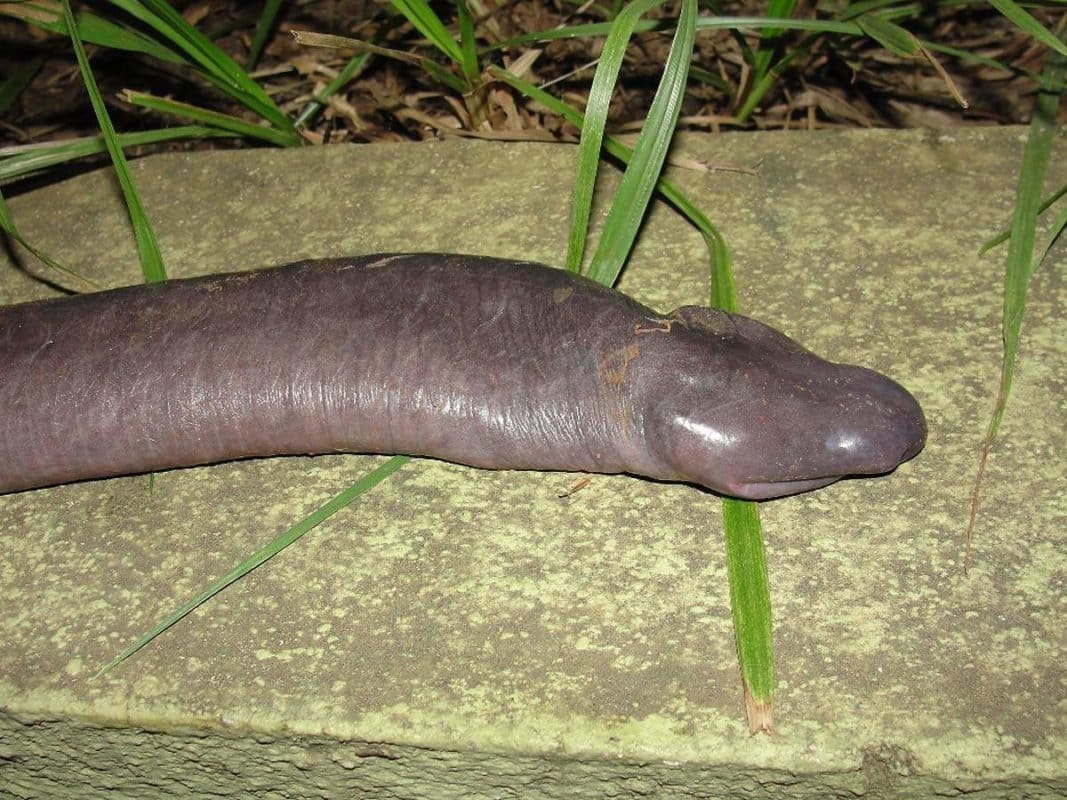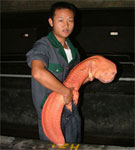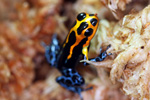A creature discovered by engineers building a dam in the Amazon is a type of caecilian, a limbless amphibian that resembles an earthworm or as some are noting, part of the male anatomy.
The animal was discovered while draining a portion of the Madeira River — a major tributary of the Amazon — for a controversial hydroelectric project. Six individuals were found according to biologist Julian Tupan, who identified the species as Atretochoana eiselti. Little else is known about the species, although it is thought to be aquatic and lacks lungs, breathing through its skin instead. Other individuals have been found near the mouth of the Amazon, more than 2,500 km away. Caecilians are typically predators, feeding on small fish, worms, and other aquatic invertebrates. They have poor eye-sight and navigate primarily though smell.
Atretochoana eiselti is the largest known caecilian, attaining a length of 81 cm (32 inches), or more than twice the size of the next-largest known species.


Atretochoana eiselti‘s population status is unknown, but the area where it was most recently discovered will soon be impacted by the Santo Antonio Dam near Porto Velho in Rondonia. Environmentalists have criticized the project, noting it will flood rainforest and require degazetting a section of national park. Brazil is currently in the midst of a dam-building spree in the Amazon, with 30 dams on tap for 2020. Ecologists warn the dam-building activity could affect fish migration and nutrient flows through the Amazon basin (special series: Amazon dams.
Species: Atretochoana eiselti is a type of caecilian, a limbless amphibian.
Habitat and range: The “penis snake” has been found in Brazil near the mouth of the Amazon and in the Madeira River (the largest tributary of the Amazon River). Both are considered “white-water” rivers, with limited visibility due to high silt loads. It is presently unknown what other rivers the “penis snake” inhabits and whether it occurs upstream in Peru or Bolivia.
Size: Lengths of 81 cm (32 inches) have been documented
Feeding habits: Like other caecilians, the “penis snake” likely feeds on small fish, worms, and other aquatic invertebrates. But more research is needed
First discovered: Atretochoana eiselti was first described in 1968 paper published in The Caecilians of the World. Its “rediscovery” was published in 1998.
Related species: Atretochoana eiselti is the only species in the genus Atretochoana, but another caecilian — Caecilita iwokramae — is also known to lack lungs. There are nearly 200 species of caecilian known worldwide, including a superficially similar one discovered in French Guiana in 2013.
Origin of the name: Mongabay.com coined the name “penis snake” in the August 1, 2012 post above. Since then, other media outlets have come up with some creative monikers including the “manaconda” and the “floppy snake”.
CITATIONS:
- Wilkinson, M., Sebben, A., Schwartz, E.N.F., and Schwartz, C.A. (1998). “The largest lungless tetrapod: report on a second specimen of Atretochoana eiselti (Amphibia: Gymnophiona: Typhlonectidae) from Brazil.” Journal of Natural History, 32, 617-627
- Hoogmoed, M.S., Maciel, A.O., and Coragem, J.T. (2011). ”Discovery of the largest lungless tetrapod, Atretochoana eiselti (Taylor, 1968) (Amphibia: Gymnophiona: Typhlonectidae), in its natural habitat in Brazilian Amazonia.” Boletim do Museu Paraense Emílio Goeldi. Ciências Naturais, 6(3), 241-262.
Related articles

Relative of the ‘penis snake’ discovered in South America
Last chance to see: the Amazon’s Xingu River
The dark side of new species discovery

(12/21/2011) Scientists and the public usually rejoice when a new species is discovered. But biologist Bryan Stuart has learned the hard way that the discovery of new species, especially when that species is commercially valuable, has a dark side-one that could potentially wipe out the new species before protections can be put in place. Stuart has discovered 27 species unknown previously to scientists – so far. That includes 22 species of frogs, three types of snakes, and two salamanders. His experience with one of these, a warty salamander from Laos with striking markings (Laotriton laoensis), opened his eyes to a dark side of scientific discovery: commercial overexploitation before protections are in place. Shortly after Stuart described the previously unknown species Paramesotriton laoensis in a scientific paper published in 2002, commercial dealers began collecting this Lao newt for sale into the pet trade. In essence, the dealers used Stuart’s geographic description in the paper as a “roadmap” to find the rare newt.
World’s bluest lizard in danger?

(03/07/2007) High above the forest floor on the remote Colombian island of Gorgona lives a lizard with brilliant blue skin, rivaling the color of the sky. Anolis gorgonae, or the blue anole, is a species so elusive and rare, that scientists have been unable to give even an estimate of its population. Due to the lizard&spod;s isolated habitat and reclusive habits, researchers know little about the blue anole, but are captivated by its stunning coloration.